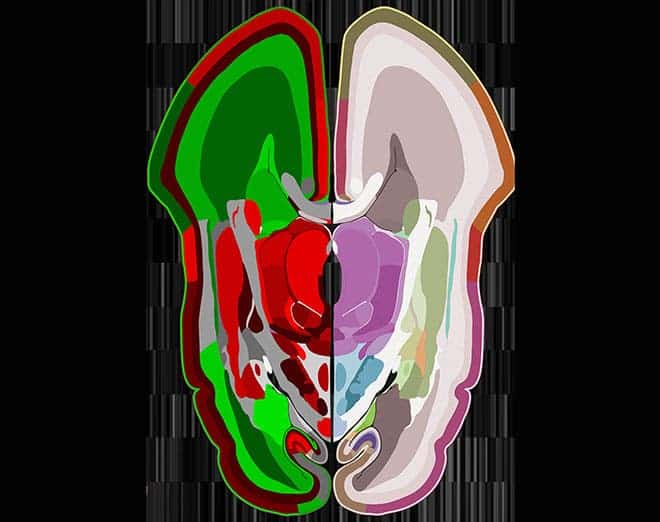
The red and green brain slice (left) illustrates activity levels for a single gene. The multicolor slice (right) is a reference atlas, with different colors corresponding to different anatomical zones. Image: Miller et al., Nature
Prepare to enter the era of Big Neuroscience. For the past decade or so, billions worth of research has provided some of the most tantalizing clues about how the human brain works, and consequently we, as human beings, reason. There are millions of people in the world suffering from dreaded neurodegenerative diseases, like Alzheimer’s or Huntington’s, so understanding how all the intricate genetic and biological mechanics fit together to birth the most complex organism in the known Universe – the human brain – is of paramount importance to us, as a species and as sentient beings!
Despite huge efforts, we’re still just making baby steps. Speaking of which, researchers at the Allen Institute report they’ve released the most detailed map ever made of the fetal human brain. The scientists are still dissecting the huge amount of data gathered so far, but already the map reveals important clues that shed light on how the infant human brain forms or what the biological origins of afflictions like autism may be.
The prenatal brain
The human brain is among the most complex structures in the entire universe, containing roughly 100 billion neurons — as many stars as are in the Milky Way. Before the brain can foster a beautiful human mind, however, the neurons first form in the fetus. Halfway through gestation, the human brain is no larger than the palm of your hand. It is around this time that the cortex, the part of the brain that is responsible for cognition, begins to form.
Neuroscientists at the Allen Institute for Brain Science in Seattle first sliced four fetal brains obtained through a tissue bank, each into 3,000 ultra-thin sections. Most of these sections were dyed and implanted with genetic markups to form the atlas, while others were sampled directly using a laser to gather genetic information. In all, the activity of some 20,000 genes was analyzed.
The data set will allow scientists to test new hypotheses about how the particular genetic codes of different brain areas lead to the unfathomably complex, unified organ. For now, the researchers are only beginning to dwell deeper in the huge data set. Still, some important hints have already been observed. . For example, 34 genes whose sequences differ in interesting ways between humans and other primates appeared to be especially active in the developing frontal cortex. This are of the brain is considered of key importance for social interactions.
The team also investigated 78 genes previously linked with autism, and found that they appeared to be enriched in newly generated neurons in the cortex. The findings appeared in the journal Nature. In the same issue, researchers from the Allen Institute also published the most complete wiring diagram of a mammalian brain to date – a mouse.
The Allen Mouse Brain Connectivity Atlas contains more than 1.8 petabytes of data — the equivalent of 23.9 years of continuous HD video — all of which is freely available online to the entire community. The research team behind the Atlas has been steadily releasing new data since November 2011; and in March, they released the last major update to the Atlas, though the resource will continue to be updated as technology develops and researchers are able to add more new types of connectivity data. Like all of the Allen Brain Atlas resources, the data and the tools to browse and analyze them are freely available to the public at http://www.brain-map.org.









